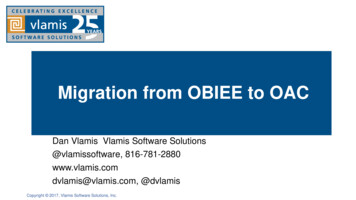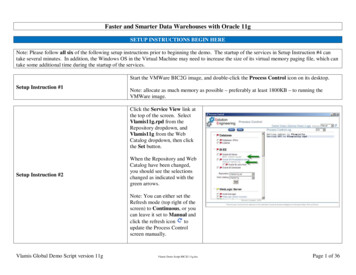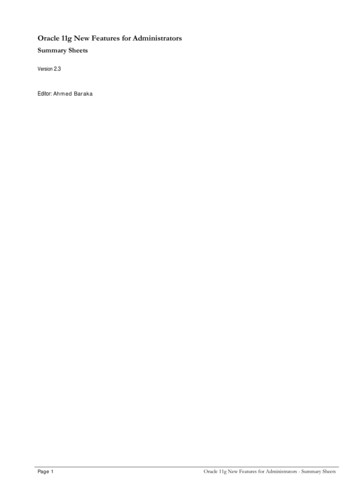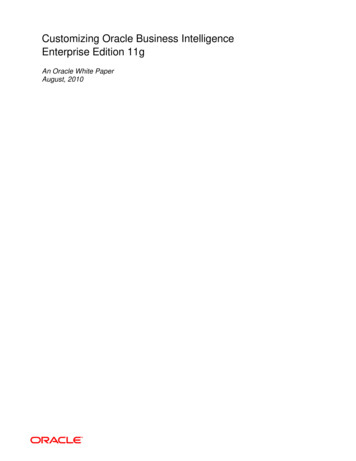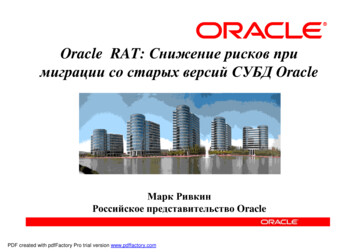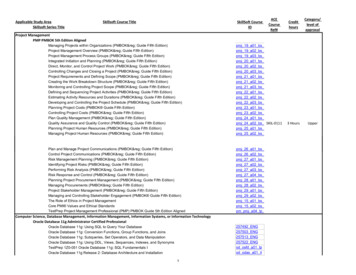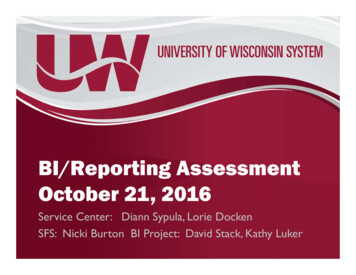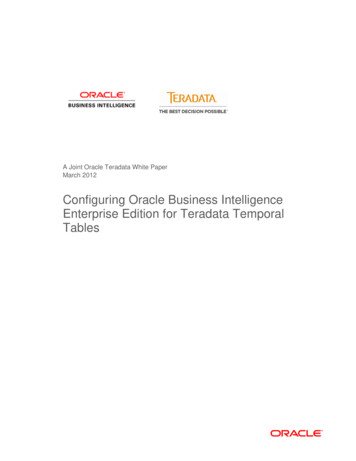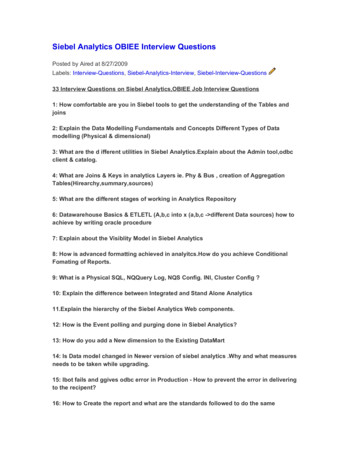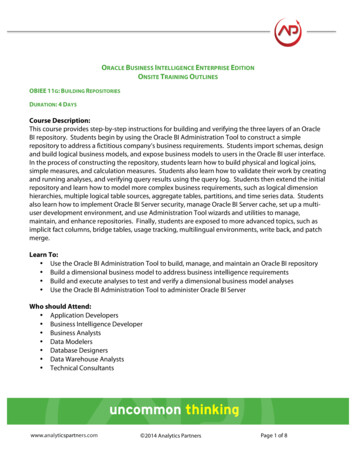
Transcription
ORACLE BUSINESS INTELLIGENCE ENTERPRISE EDITIONONSITE TRAINING OUTLINESOBIEE 11G: BUILDING REPOSITORIESDURATION: 4 DAYSCourse Description:This course provides step-by-step instructions for building and verifying the three layers of an OracleBI repository. Students begin by using the Oracle BI Administration Tool to construct a simplerepository to address a fictitious company’s business requirements. Students import schemas, designand build logical business models, and expose business models to users in the Oracle BI user interface.In the process of constructing the repository, students learn how to build physical and logical joins,simple measures, and calculation measures. Students also learn how to validate their work by creatingand running analyses, and verifying query results using the query log. Students then extend the initialrepository and learn how to model more complex business requirements, such as logical dimensionhierarchies, multiple logical table sources, aggregate tables, partitions, and time series data. Studentsalso learn how to implement Oracle BI Server security, manage Oracle BI Server cache, set up a multiuser development environment, and use Administration Tool wizards and utilities to manage,maintain, and enhance repositories. Finally, students are exposed to more advanced topics, such asimplicit fact columns, bridge tables, usage tracking, multilingual environments, write back, and patchmerge.Learn To: Use the Oracle BI Administration Tool to build, manage, and maintain an Oracle BI repository Build a dimensional business model to address business intelligence requirements Build and execute analyses to test and verify a dimensional business model analyses Use the Oracle BI Administration Tool to administer Oracle BI ServerWho should Attend: Application Developers Business Intelligence Developer Business Analysts Data Modelers Database Designers Data Warehouse Analysts Technical Consultantsuncommon thinkingwww.analyticspartners.com 2014 Analytics PartnersPage 1 of 8
ORACLE BUSINESS INTELLIGENCE ENTERPRISE EDITIONONSITE TRAINING OUTLINESCourse Objectives: Build the Physical, Business Model and Mapping, and Presentation layers of a repository Set up query logging for testing and debugging Build and run analyses to test and validate a repository Manage multiple logical table sources in a repository Build simple and calculated measures for a fact table Create logical dimensions with level-based hierarchies and level-based measures Create logical dimensions with parent-child hierarchies Model aggregate tables to speed up processing Model partitions and fragments to improve application performance and usability Use variables to streamline administrative tasks and dynamically modify metadata content Use time series functions to support historical time comparison analyses Use bridge tables to resolve many-to-many relationships between dimension and fact tables Configure Oracle BI to support multilingual environments Use implicit fact columns to select fact tables for dimension-only queries Create a repository by using a multidimensional data source Set up security to authenticate users and assign appropriate permissions and privileges Apply cache management techniques to maintain and enhance query performance Enable usage tracking to track queries and database usage and to improve query performance Set up and use a multiuser development environment Set up and configure “write back” to enable users to modify data in analyses Perform a repository patch merge in a development-to-production scenario Define user-preferred currency options Use Administration Tool utilities and wizards to perform administrative tasks Identify best practices for optimizing end-user query performance when implementing OracleBI Identify and apply repository design principles and best practicesuncommon thinkingwww.analyticspartners.com 2014 Analytics PartnersPage 2 of 8
ORACLE BUSINESS INTELLIGENCE ENTERPRISE EDITIONONSITE TRAINING OUTLINESDAY 1:1. Repository Basics Exploring Oracle BI architecture components Exploring a repository’s structure, features, and functions Using the Oracle BI Administration Tool Creating a repository Loading a repository into Oracle BI Server memory2. Building the Physical Layer of a Repository Importing data sources Setting up connection pool properties Defining keys and joins Examining physical layer object properties Creating alias tables3. Building the Business Model and Mapping Layer of a Repository Building a business model Building logical tables, columns, and sources Defining logical joins Building measures Examining business model object properties4. Building the Presentation Layer of a Repository Exploring Presentation layer objects Creating Presentation layer objects Modifying Presentation layer objects Examining Presentation layer object propertiesuncommon thinkingwww.analyticspartners.com 2014 Analytics PartnersPage 3 of 8
ORACLE BUSINESS INTELLIGENCE ENTERPRISE EDITIONONSITE TRAINING OUTLINESDAY 2:5. Testing and Validating a Repository Checking repository consistency Turning on logging Defining a repository in the initialization file Executing analyses to test a repository Inspecting the query log6. Managing Logical Table Sources Adding multiple logical table sources to a logical table Specifying logical content7. Adding Calculations to a Fact Creating new calculation measures based on existing logical columns Creating new calculation measures based on physical columns Creating new calculation measures using the Calculation Wizard Creating measures using functionsuncommon thinkingwww.analyticspartners.com 2014 Analytics PartnersPage 4 of 8
ORACLE BUSINESS INTELLIGENCE ENTERPRISE EDITIONONSITE TRAINING OUTLINESDAY 3:8. Working with Logical Dimensions Creating logical dimension hierarchies Creating level-based measures Creating share measures Creating dimension-specific aggregation rules Creating presentation hierarchies Creating parent-child hierarchies Using calculated members9. Using Aggregates Modeling aggregate tables to improve query performance Setting the number of elements in a hierarchy Testing aggregate navigation Using the Aggregate Persistence Wizard10. Using Partitions and Fragments Exploring partition types Modeling partitions in an Oracle BI repository Using the Calculation Wizard to create derived measures11. Using Repository Variables Creating session variables Creating repository variables Creating initialization blocks Using the Variable Manager Using dynamic repository variables as filtersuncommon thinkingwww.analyticspartners.com 2014 Analytics PartnersPage 5 of 8
ORACLE BUSINESS INTELLIGENCE ENTERPRISE EDITIONONSITE TRAINING OUTLINESDAY 4:12. Modeling Time Series Data Using time comparisons in business analysis Using Oracle BI time series functions to model time series data13. Modeling Many-to-Many Relationships Using bridge tables to resolve many-to-many relationships between dimension tablesand fact tables14. Localizing Oracle BI Metadata and Data Localizing repository metadata Localizing Oracle BI data15. Setting an Implicit Fact Column Adding fact columns automatically to dimension-only queries Ensuring the expected results for dimension-only queries Specifying a default join path between dimension tables16. Importing Metadata from Multidimensional Data Sources Importing a multidimensional data source into a repository Incorporating horizontal federation into a business model Incorporating vertical federation into a business model Adding Essbase measures to a relational model Displaying data from multidimensional sources in Oracle BI analyses and dashboards17. Security Exploring Oracle BI default security settingsCreating users and groupsCreating application rolesSetting up object permissionsSetting row-level security (data filters)Setting query limits and timing restrictionsuncommon thinkingwww.analyticspartners.com 2014 Analytics PartnersPage 6 of 8
ORACLE BUSINESS INTELLIGENCE ENTERPRISE EDITIONONSITE TRAINING OUTLINES18. Cache Management Restricting tables as non-cacheable Using Cache Manager Inspecting cache reports Purging cache entries Modifying cache parameters and options Seeing the cache19. Enabling Usage Tracking Setting up the sample usage tracking repository Tracking and storing Oracle BI Server usage at the detailed query level Using usage tracking statistics to optimize query performance and aggregation strategies Analyzing usage results using Oracle BI Answers and other reporting toolsuncommon thinkingwww.analyticspartners.com 2014 Analytics PartnersPage 7 of 8
ORACLE BUSINESS INTELLIGENCE ENTERPRISE EDITIONONSITE TRAINING OUTLINESDAY 5:20. Multiuser Development Setting up a multiuser development environment Developing a repository using multiple developers Tracking development project history21. Configuring Write Back Enabling write back in a repository Creating a write back template Granting write back privileges Enabling write back in an analysis Comparing repositories Equalizing objects Creating a patch Applying a patch Making a merge decisionsuncommon thinkingwww.analyticspartners.com 2014 Analytics PartnersPage 8 of 8
OBIEE 11G: BUILDING REPOSITORIES DURATION: 4 DAYS Course Description: This course provides step-by-step instructions for building and verifying the three layers of an Oracle BI repository. Students begin by using the Oracle BI Administration Tool to construct a simple repository to address a fictitious company's business requirements.
